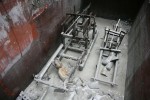 An archaeological survey of a subway construction site in Chengdu, Sichuan province, southwestern China, unearthed a tomb containing four model looms. It dates to the reigns of the Han Dynasty Emperors Jingdi (157 to 141 B.C.) and Wudi (141 to 88 B.C.). The tomb is 24 feet long, 16 feet wide and 9 feet high and made of painted wood. It is divided into five chambers, a full-length burial chamber above, four small chambers underneath. Archaeologists discovered the remains of a woman about 50 years of age. While the jade seal on her coffin was broken, likely by tomb robbers not long after the burial, her name can still be read on it: Wan Dinu.
An archaeological survey of a subway construction site in Chengdu, Sichuan province, southwestern China, unearthed a tomb containing four model looms. It dates to the reigns of the Han Dynasty Emperors Jingdi (157 to 141 B.C.) and Wudi (141 to 88 B.C.). The tomb is 24 feet long, 16 feet wide and 9 feet high and made of painted wood. It is divided into five chambers, a full-length burial chamber above, four small chambers underneath. Archaeologists discovered the remains of a woman about 50 years of age. While the jade seal on her coffin was broken, likely by tomb robbers not long after the burial, her name can still be read on it: Wan Dinu.
 It was in one of the four rooms under the burial chamber that the model looms were found. Made of wood and bamboo, the model looms have preserved cinnabar-dyed red silk threads and brown silk threads on the beams. Each of the models is to scale, about 1/6th the size of their full-size cousins, and come with an array of accessories and operators which are also about 1/6th life-sized. There are tools for warping, rewinding and weft winding and 15 carved figurines including weavers (four men) and their assistants (nine women). The weavers are about 10 inches high and are depicted in action poses, warping, rewinding and weft winding, just as their real-life counterparts would do using the tools also included in the loom tableau. The figurines all have individual names written on the breast, which means they were probably representations of actual weavers and their assistants.
It was in one of the four rooms under the burial chamber that the model looms were found. Made of wood and bamboo, the model looms have preserved cinnabar-dyed red silk threads and brown silk threads on the beams. Each of the models is to scale, about 1/6th the size of their full-size cousins, and come with an array of accessories and operators which are also about 1/6th life-sized. There are tools for warping, rewinding and weft winding and 15 carved figurines including weavers (four men) and their assistants (nine women). The weavers are about 10 inches high and are depicted in action poses, warping, rewinding and weft winding, just as their real-life counterparts would do using the tools also included in the loom tableau. The figurines all have individual names written on the breast, which means they were probably representations of actual weavers and their assistants.
The largest of the four looms is 33 inches long, 10 inches wide and 20 inches high, about the size of a toy piano, but its historical significance is oversized.
“We are very sure that the loom models from Chengdu are the earliest pattern looms around the world,” said the study’s lead researcher, Feng Zhao, the director of the China National Silk Museum in Hangzhou, China, and a professor at Donghua University in Shanghai.
It’s thought that the earliest looms date to China’s Neolithic age, including looms found in China’s eastern Zhejiang province: an approximately 8,000-year-old loom from the Kuahuqiao site; and a roughly 7,000-year-old loom found at the Hemudu site, Zhao said. Other looms include pieces of Egyptian creations from about 4,000 and 3,400 years ago, respectively, and Greek looms illustrated on vases dating to about 2,400 years ago, the researchers said.
However, unlike their predecessors, pattern looms are used to weave a “complex kind of textile,” Zhao told Live Science in an email. Weavers used this type of loom to create patterns by stringing up the weft (the crosswise yarn on the loom) and weaving the warp (the longitudinal yarn that is passed over and under the weft) through it, he said.
 These model looms are replicas in miniature of a technology that revolutionized silk manufacture in the 3rd century, making possible the creation of the famed Han Dynasty Shu jin silks, textiles that were traded across Europe, Asia and the Levant via the Silk Road.
These model looms are replicas in miniature of a technology that revolutionized silk manufacture in the 3rd century, making possible the creation of the famed Han Dynasty Shu jin silks, textiles that were traded across Europe, Asia and the Levant via the Silk Road.
The fascinating paper on the discovery, the reconstruction of the looms, how they were operated and their historical meaning has been published in the journal Antiquity and can be read in its entirety free of charge here.